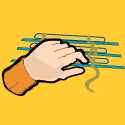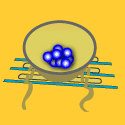

Experiment Category:
Objective:
What You Need:
- 5 Craft Sticks
- 4 Twist Ties
- 4 Straws
- 1 Styrofoam cup
- Bag of Marbles
To Do and Observe:
CHALLENGE: You need to build a raft to get across the river, so you want to make a small model to test your design.
1. Using 5 craft sticks, 4 twist ties, 4 straws, and 1 Styrofoam cup; build a raft that will support a Dixie cup with marbles in it.
2. When you have completed you structure, add the marbles one at a time until your structure is no longer afloat. How many marbles can your raft hold?
3. Compare the design of your boat to that of the other students around you. Were there any differences? Any similarities?
What's Going On:
This activity allows us to create structures that can float on water. Objects can float on water because of density and buoyancy. Density is the ratio of mass of a substance to its volume. Mass is the measurement of the amount of matter that something contains. The mass of an object is different than the weight of an object. The weight of an object can change depending on its location, but the mass will remain the same. Volume is the amount of space that an object takes up. Objects that float on water are referred to as being less dense, or lighter than water. Objects that sink in water are denser, or heavier than water.Buoyancy is the upward force that keeps things afloat. When placed in water, an object will float if its buoyancy is greater than its weight. And it will sink if its weight is greater than its buoyancy. You can increase the amount of buoyancy that an object has by increasing the surface area that the water is pushing against. Think about being in a pool. If you wrap your arms around your legs and curl up into a ball, what happens? (You’ll sink.) What if you stretch your body out flat? (You’ll float.)As students construct their rafts they use materials that are all less dense than water, which allows the raft to float. How they position the cup and the craft sticks will determine how many marbles their rafts will be able to hold.
Parent/Teacher Tips:
NOTE: The straws need to be sealed in order for them to float. Try to use the straws sealed in plastic, the paper sealed ones will just break down.
To demonstrate what buoyancy is, you can do a quick demo using clay. Take a piece of clay and split it unto 2 identical pieces. Roll one half into a ball and shape the other piece into a flat boat shaped object. Place both pieces of clay into the water and observe what happens. The balled up clay will sink and the boat shaped piece will float.
For Younger Kids To make this challenge a little simpler for younger students you can simplify the challenge so that they only need to create a model that can float on water. You can also use clay to plug the holes in the straws so that water is not getting into them. Using larger craft sticks that look like tongue depressors might also make it easier because they cover a larger surface area and make it a little easier to build a structure that floats. If students are having difficulties coming up with a design, have them draw or think of things that can float on water. What shapes are they? Do they have openings at the bottom?
